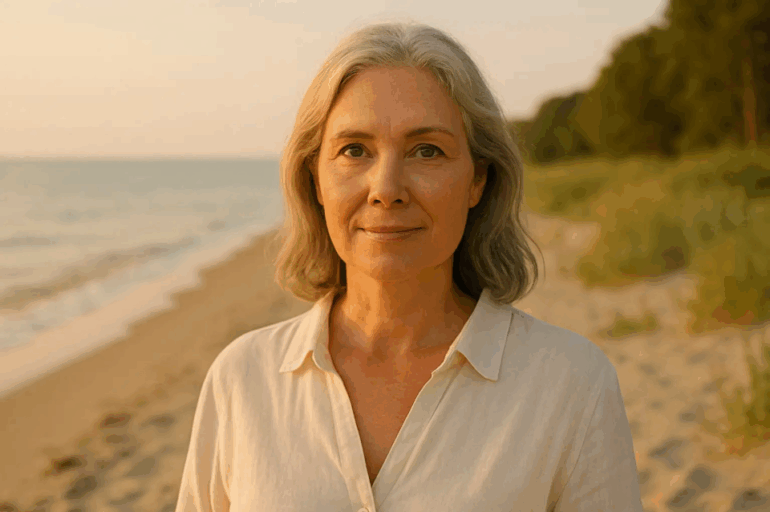The most common symptoms of menopause are hot flashes, night sweats, insomnia, mood changes, joint pain, and vaginal dryness. These usually begin between ages 45 and 55 (the perimenopausal stage), peak around the time of menopause (defined as 12 months without menstruation), and lessen during postmenopause. Vaginal dryness can be particularly persistent, but can be alleviated with lifestyle habits, local treatments, and nutritional support (e.g., OlioVita, a sea buckthorn oil rich in Omega-7).
Foundations: What Is Menopause, When Does It Begin, and What Are the First Symptoms?
Menopause is clinically defined as the absence of menstruation for 12 consecutive months, caused by a sustained decline in oestrogen and progesterone. These hormonal changes explain symptoms like hot flushes, sleep and mood disturbances, as well as dryness of the skin and mucous membranes, including vaginal tissues.
Clinically, the menopausal transition is divided into three stages:
-
Perimenopause: The months or years before the final period—characterised by irregular cycles and vasomotor symptoms (hot flushes, night sweats), alongside sleep and mood disturbances. Vaginal dryness may begin in this phase.
-
Menopause: Confirmed after 12 months without menstruation.
-
Postmenopause: The phase thereafter, when some symptoms (e.g., hot flushes) may lessen, but issues like bone and cardiovascular health—and persistent vaginal dryness if untreated—become more prominent.
List of Menopausal Symptoms
| Physical Symptoms | Emotional Symptoms | Less Common Symptoms |
|---|---|---|
| Hot flashes & night sweats | Mood swings | Tingling in limbs |
| Headaches | Anxiety or depression | Dry eyes and skin |
| Insomnia | Difficulty concentrating | Tinnitus (ringing in ears) |
| Vaginal dryness | Subjective memory loss | Altered sense of smell/taste |
| Joint and muscle pain | Lowered self-esteem | Palpitations or rapid heartbeat sensation |
Initial Signs: How to Recognise the Start (Perimenopause)
Common early signals include irregular periods, occasional hot flushes, sleep problems, and emerging vaginal dryness.
Practical indicators:
-
Menstrual cycles that shorten or lengthen (e.g., from 28 days to 24 or up to 45 days).
-
Waking up sweating at night without having a fever.
-
Difficulty falling asleep or waking up too early.
-
Noticing less natural lubrication, and increased tightness or burning, especially with sexual activity.
-
Mood swings that are more intense than previous premenstrual symptoms.
Symptoms by Age
-
40–45 years (early/premature menopause): Menstrual irregularities, mild hot flushes, mood changes, initial signs of dryness.
-
45–49 years: More frequent hot flushes, insomnia, anxiety, vaginal dryness that may impact comfort.
-
50–55 years: Aches and pains, loss of muscle mass, increased risk to bone health, weight gain, persistent vaginal dryness if untreated.
-
Post-55 years (postmenopause): In many women, hot flushes decrease—but focus shifts to bone and cardiovascular health, although vaginal dryness may persist if not specifically managed.
Vaginal Dryness
Causes, Signs, and Impact
Vaginal dryness results from the drop in oestrogen levels, which reduces lubrication, thins the mucous lining, and raises vaginal pH.
Physiologically:
-
Less oestrogen → reduced mucus and lubrication.
-
Thinner, less elastic mucosa → more friction and micro-irritations.
-
Higher pH → disrupted microbiota → increased infection risk and discomfort.
Common symptoms:
-
Tightness, itching, or burning in the vagina.
-
Pain during intercourse (dyspareunia).
-
Micro-tears or spotting post-intercourse.
-
Sensation of dryness during prolonged sitting, exercise, or tight clothing.
Quality-of-life effects:
-
Reduced frequency of sexual activity due to pain or fear.
-
Lowered sexual desire (sometimes due more to anticipation of pain than libido itself).
-
Emotional and relational strain if symptoms are not discussed and addressed.
Checklist for Your Healthcare Visit
-
Dates of your last six periods (if applicable).
-
Three most bothersome symptoms.
-
Treatments or products tried and your response.
-
Key questions (e.g., “Am I a candidate for local oestrogens?” “How to integrate OlioVita with my current routine?”).
FAQs about Menopausal Symptoms
-
What are the most common symptoms?
Hot flushes, night sweats, insomnia, vaginal dryness, mood changes, and joint pain. -
What age do symptoms begin?
Most commonly between 45 and 55, though perimenopause can start earlier (around 40). -
How long do symptoms last?
On average, 4–7 years, though this varies. Vaginal dryness may continue if not treated. -
Can vaginal dryness be treated?
Yes—combining moisturisers/lubricants, gentle habits, and nutritional support (like OlioVita). A doctor may also prescribe local oestrogen if needed. -
Is hormone therapy necessary?
Not always. It’s effective for suitable candidates, but non-hormonal approaches can also help. -
What’s the difference between a lubricant and a moisturiser?
A lubricant provides lubrication during intercourse. A moisturiser improves baseline comfort with regular use.
Key summary:
-
Symptoms: hot flushes, insomnia, vaginal dryness, mood changes, joint pain.
-
Typical onset: 45–55 years (perimenopause); confirmed after 12 months without menstruation.
-
Duration: generally 4–7 years, with vaginal dryness potentially lasting longer if untreated.
-
Solutions: gentle routines, moisturisers + lubricants, nutritional support (e.g., OlioVita), and seeking clinical options if necessary.
-
Red flags: postmenopausal bleeding, severe pain, intense dyspareunia, profound low mood.
Key Takeaway
Menopause is a natural life transition marked by a range of symptoms that vary in severity and duration. Vaginal dryness, in particular, can significantly affect daily comfort and intimacy, and tends to persist if not properly addressed. The encouraging news is that it is treatable. A multilayered strategy—including gentle self-care, consistent local hydration and lubrication, and nutritional support from within (like OlioVita)—can make a meaningful difference. For further relief, consult a healthcare professional about suitable local or hormonal treatments.




